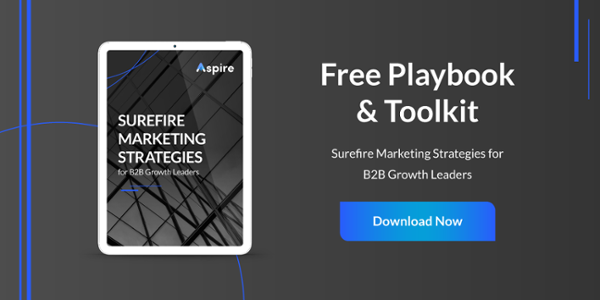- Small Business Marketing
- Conversion Rate Optimization
- October 8, 2021
What a Website Conversion Rate Is and How to Improve It

Aaron Marks

How many leads and requests to purchase does your website generate for you each month? The job of your B2B business website isn’t just to inform your customers. It should be your primary engine for generating leads and new business.
If you’re not quite getting all the juice out of your website that you’d like, it’s a good idea to take a look at your website and learn how you can improve it. In this article, we discuss the importance of understanding what your website conversion rate is and give you some starting tips on how to increase it.
What is a Website Conversion Rate?
A website conversion is a favorable action for your company, such as signing up for your newsletter, downloading your eBook, or checking out. The website conversion rate is the number of these favorable conversions divided by the number of website sessions.
A website session is defined by Google Analytics as a group of interactions recorded when a user visits your website within a given time frame. A session begins when a user visits a page of your site and concludes when the user leaves or after 30 minutes of inactivity.
You can track a single conversion or track multiple conversions. It’s important for your business to determine what conversion(s) to track. For example, if your business goal is building its contact list, you should track an email signup as a conversion. Alternatively, if you want to nurture your middle of the funnel audience and educate them towards making a purchase, you could track an asset download, such as an ebook, as a conversion.
Why is Improving Your Website Conversion Rate Important?
Improving your website conversion rate means a higher percentage of your website visitors are taking action. This could mean more email signups to your contact list, nurturing leads, or more purchases.
It’s important to improve your website conversion rate to maintain and grow your business. With an improved website conversion rate, you generate more leads, re-engage existing customers, and encourage visitors to make a purchase.
How to Improve Your Website Conversion Rate
There are many strategies to increase your website conversion rate. Some are more complex than others. As you’re getting started with improving your website conversion rate, there are a few simple steps you can take we discuss in this article.
Take Note of Existing Website Visitor Patterns
Some factors that hurt an organization's website conversion rate include slow page load times and broken forms. As a starting place, you can use Google’s PageSpeed tool to test load times. You should also test your forms to ensure they all work, and they are easy to use. One powerful form tool we recommend is HubSpot, since it integrates with your website and has an easy-to-use CRM.
Beyond these two quicker fixes, it can be difficult to determine the aspects of your website you should optimize for better conversions. That’s why it’s so important to analyze your current visitors’ actions. You can determine where they're losing interest or where they’re getting stuck.
There are many tools to help you do this. Google Analytics, for example, helps you determine which pages are the most popular and how visitors are reaching that page. Hotjar is another useful tool that records website visitors and shows you how they move through your site. It also offers heatmaps to show you where your visitors are clicking and spending the most of their time.
It’s important to understand how your customers are navigating your website, so you can optimize its various components. Understanding visitor patterns helps you create a higher performing website. You can learn which pages are the most popular, which pages have a high bounce rate, which pages have a high exit rate, and which pages aren’t receiving a lot of traffic.
It’s also important to track your bounce rate to determine whether your website content is matching up to your website visitors’ needs. Bounce rate is the percentage of visitors that leave your site without taking any action, such as clicking a link, visiting another page or filling a form.
Finally, it’s important to track your exit rate to understand how specific pages are performing and to see which pages people are exiting the most. Exit rate can be calculated as the number of exits over the number of pageviews for a specific page.
Add More Conversion Opportunities
Not all of your website visitors are ready to purchase your product or service. They are all at different stages of the marketing or sales funnel. Some visitors may already be familiar with your brand and ready to buy from you. Others may just be discovering your website for the first time and getting to know your brand. Therefore, you should incorporate various types of conversion opportunities within your website, targeting your audience at each stage of the buyer’s journey.
For example, you can educate the portion of your audience that isn’t ready to buy with whitepapers, eBooks, webinars, and other assets. This helps build trust with your audience, and makes it more likely they think of you when they are ready to buy. If your only conversion opportunities involve contacting your business, scheduling a demo, or grabbing a quote, you’re missing out on capturing potential leads that could, over time, turn into customers.
You can incorporate these conversion opportunities on various pages throughout your website. You can include a download offer of your eBook towards the bottom of your homepage or you could incorporate offers within your blog posts.
The important thing is to increase opportunities for conversions from your website visitors, keeping in mind they are at all different stages of the funnel. Website visitors who have landed on your page for the first time will be more influenced by educational content than a visitor who is already a customer and has previously purchased from you. Make sure to provide different conversion opportunities for all your website visitors.
Test, Test, and Test Again
It’s important to test and track different elements of your website. That way, you can see what aspects of your site are driving conversions and what aspects are creating friction for visitors. Is one image performing better than another? Do images with people perform better than images without people in them? Does one button text convert better than the other?
Buttons and images are just some of the components of a website that you can test to drive better conversions. You can also test your offer placements, the navigation of your website, different header images, and much more. You can test the placement of your free ebook download offer, for example, by placing it more towards the top of your homepage or towards the bottom. In short, your goal is to determine what your website visitors are resonating with and how they like to navigate your website.
An important aspect of testing is making sure to test one thing at a time. That way, it’s possible to know what exactly is driving conversions. It’s also important to make sure the time frame of your test is long enough to collect valuable data. Setting an appropriate time frame is essential in order to ensure more accurate data and reduce the risk of one-off mishaps, such as slow internet speeds or down web servers.
Improving your Website Conversion Rate for Business Growth
It’s important to understand your website conversion rate and make efforts to improve it so you can acquire leads at all stages of the funnel and nurture them into paying customers. Improving your website conversion rate is essential for your business growth. But, it doesn’t have to take up all your time, nor does it require tons of effort to see major improvements.
You can start off by making simple updates to your site, first by understanding existing visitor behaviors, then by making small tweaks such as adding more conversion opportunities, and testing out different images. Understanding your website conversion rate and taking small steps to improve it, will lead to more conversions and happier visitors, resulting in business growth for your company.
Aaron Marks is the Chief Marketing Officer of Execo. A digital pioneer with nearly two decades of online marketing experience, Aaron has helped organizations ranging from fledgling startups to Fortune 500 enterprises, and global manufacturers to U.S. Presidential campaigns, get the marketing and business results they needed.



0 Comments